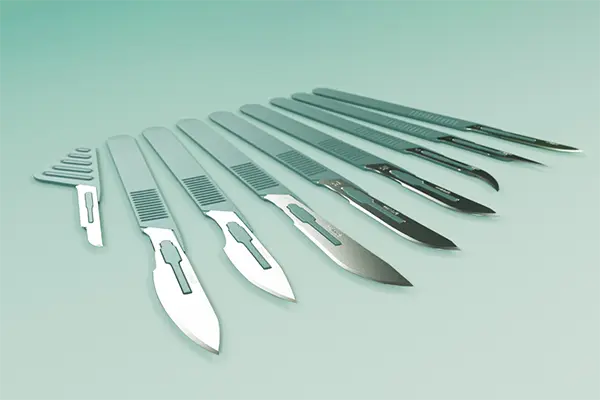Surgical blades are essential tools in medical and surgical procedures, designed for precision cutting and incisions. They come in various shapes and sizes, each suited for specific tasks. Among the many types of surgical blades, the #10 blade is recognized as the most common and widely used. Its versatility and reliability make it a staple in surgical settings across the world.
In this article, we’ll explore the characteristics of the #10 blade, its uses, and why it is the most preferred choice in the operating room. Additionally, we’ll discuss other popular blade types and their applications in surgical practice.
What Is a Surgical Blade?
A surgical blade is a small, sharp instrument used for cutting or dissecting tissues during surgical procedures. Typically, these blades are made of high-quality stainless steel or carbon steel to ensure durability, sharpness, and sterility. They are often attached to a scalpel handle, which provides a firm grip and control for the surgeon.
Surgical blades are classified by numbers, with each number denoting a specific shape and size. This classification allows surgeons to choose the right blade for the task at hand.
Characteristics of the #10 Blade
The #10 blade is the most common surgical blade and is characterized by its curved cutting edge and flat, broad blade. These features make it ideal for a variety of tasks that require precision and control. Key attributes include:
- Curved Edge: The curved cutting edge provides smooth, precise incisions, especially on flat surfaces like the skin.
- Broad Blade: The wide blade ensures stability and control during cutting, minimizing the risk of accidental tissue damage.
- Versatility: Its design makes it suitable for a wide range of surgical procedures, from minor cuts to more complex incisions.

Common Uses of the #10 Blade
The #10 blade is employed in numerous medical and surgical applications, including:
1. General Surgery
In general surgery, the #10 blade is used for making long, smooth incisions in the skin, subcutaneous tissue, and fascia. These precise cuts are essential for procedures such as:
- Appendectomies
- Hernia repairs
- Abdominal surgeries
2. Dermatology
The blade is commonly used in dermatological procedures for excising skin lesions, cysts, and tumors. Its sharpness and control allow for clean cuts, reducing scarring and promoting faster healing.
3. Obstetrics and Gynecology
In obstetrics and gynecology, the #10 blade is often used during cesarean sections and episiotomies, where clean and precise incisions are crucial for both the mother and the baby.
4. Veterinary Medicine
Veterinarians also rely on the #10 blade for animal surgeries, including spaying, neutering, and other soft tissue procedures.
5. Autopsies and Pathology
Pathologists use the #10 blade during autopsies and tissue sampling for its ability to make clean and accurate cuts on a variety of tissues.
Other Common Surgical Blades
While the #10 blade is the most common, other blade types also play essential roles in surgical practice:
- #11 Blade: This blade features a pointed tip and a straight edge, making it ideal for punctures, incisions in confined spaces, and precise cuts. It is commonly used in vascular surgery and arthroscopic procedures.
- #15 Blade: Known for its small, curved cutting edge, the #15 blade is used for more delicate procedures, such as plastic surgery, pediatric surgeries, and intricate dissections.
- #20 Blade: Larger than the #10 blade, the #20 is used in orthopedic and large-animal veterinary surgeries for cutting thicker tissues.
Why Is the #10 Blade the Most Common?
Versatility
The #10 blade’s ability to perform a wide range of tasks makes it indispensable in most surgical settings. From minor excisions to complex procedures, its design meets the needs of various disciplines.
Ease of Use
The broad blade and curved edge provide excellent control, reducing the learning curve for medical professionals. Its ergonomic design ensures that even novice surgeons can achieve precise results.
Availability
Given its popularity, the #10 blade is widely available and often included in basic surgical kits, ensuring accessibility in both advanced hospitals and smaller medical facilities.
Reliability
Manufactured to the highest standards, the #10 blade maintains its sharpness and integrity throughout procedures, ensuring consistent performance and safety.
Conclusion
The #10 surgical blade is the most common blade due to its versatility, reliability, and wide range of applications. Whether it’s making incisions in general surgery, dermatological excisions, or delicate gynecological procedures, the #10 blade is a trusted tool in the hands of medical professionals.
While other blades like the #11 and #15 cater to more specialized needs, the #10 remains the go-to choice for its ability to perform across various disciplines. Its prevalence in surgical practice highlights its critical role in ensuring successful outcomes for patients worldwide.
Post time: 12月-10-2024





